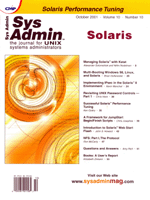 Books:
A User's Report Books:
A User's Report
Elizabeth Zinkann
In the quest for a reliable operating system, many companies continue
to choose SolarisTM. Recent releases of Solaris books address varying
degrees of user and administration experience and also specialize
in individual concepts. Some of the latest additions to the existing
Solaris repertoire include: Solaris Administration: A Beginner's
Guide by Paul Watters (Osborne McGraw-Hill); Solaris System
Management by John Philcox (New Riders); Solaris Internals:
Core Kernel Architecture by Jim Mauro and Richard McDougall
(Sun Microsystems Press, A Prentice Hall Title); and Sun Cluster
Environment, Sun Cluster 2.2 by Enrique Vargas, Joseph Bianco,
and David Deeths (Sun Blueprints, Sun Microsystems Press, A Prentice
Hall Title).
Solaris Administration: A Beginner's Guide
Paul Watters
Osborne McGraw-Hill
Network Professional's Library
ISBN 0-07-213155-1
407 Pages
$39.99
http://www.osborne.com/
Blueprints Section Included
The novice Solaris administrator, whether new to systems administration
or new to the Solaris system, often needs a logical explanation
or a procedure described in a step-by-step manner. In Solaris
Administration: A Beginner's Guide, Paul Watters defines
Solaris-specific vocabulary, naming conventions, and demonstrates
the most common Solaris processes. He divided the book into four
major parts: Installation; Single Host Administration; Managing
Internet Services; and Managing Intranet Services.
The initial section, Installation, presents an overview of the
Solaris system in the Introduction to Solaris chapter. Watters describes
Solaris installation and configuration through: Installing Solaris
SPARC (Scalable Processor Architecture); Installing Solaris Intel;
and Using the Common Desktop Environment (CDE). The second chapter
features a superb description of the SPARC design and its accompanying
advantages, especially for readers completely unfamiliar with the
SPARC platform. The author even provides some comparisons between
the SPARC and Intel architectures and performances.
Single Host Administration, the second section, concentrates on
routine use and management within a Solaris environment. Watters
examines Shell Usage and Programming; Shell Programming; Managing
Users and Groups; Processes and System Resources; and Package Management
and Software Installation. In addition to the command-line interface,
processes, signals, file ownership properties, and user/group maintenance,
this part also details Solaris implementations of system resources,
process management, packaging tools, and their counterparts --
archiving utilities. Part III: Managing Internet Services features
the techniques and services utilized for Electronic Mail; the Domain
Name Service (DNS); The Internet Daemon; Remote Access; Web Services;
and Security. The concluding section illustrates the protocols,
services, and utilities to share peripherals and files within an
organization. The individual chapters address: Samba; the Dynamic
Host Configuration Protocol (DHCP) and its configuration; the Network
File System (NFS); the Network Information System (NIS+); and Printing.
By necessity, any administration book must include explanations
of several processes and systems, each of which could easily fill
a complete book on its own. Some examples of this are networking,
Sendmail, DNS and BIND, TCP/IP, and security. In Solaris Administration:
A Beginner's Guide, Watters (who co-authored Solaris:
The Complete Reference with Sriranga Veeraraghavan, Osborne
McGraw-Hill, ISBN 0-07-212143-2, $49.99) provides a solid foundation
in Solaris administration procedures. He also demonstrates the basics
of configuring administration tasks and related features and services.
The author outlines the new capabilities in Solaris 8 and emphasizes
important considerations using Notes and Tips throughout the book.
An eight-page Blueprints insert in the middle of the book illustrates
a Solaris-Based Network, the Linux vs. Windows NT/2000-Based Network,
the Linux vs. Windows NT/2000 Boot Process, and the Solaris Boot
Process. Solaris Administration: A Beginner's Guide
is an excellent book and explains Solaris administration concepts
and procedures through a combination of description and visual representation
in an easy-to-read manner. Experienced administrators will appreciate
its thorough and practical content; beginners will value its readable
and comprehensive approach.
Solaris System Management
John Philcox
New Riders
ISBN 0-7357-1018-X
297 Pages
$39.99
http://www.newriders.com
The role of a systems manager requires both technical and managerial
skills. It demands the authority and planning to implement policies
coupled with the technical expertise to realize what is needed.
As both an experienced systems administrator and a former systems
manager, author John Philcox addresses the challenges of effective
systems management of a Solaris environment through three sections:
The System Manager, Management of the Solaris Environment, and Management
of the Solaris Network.
The first part, The System Manager, defines the responsibilities
of a systems manager and some of the job's fundamental concerns
with chapters that discuss: Job Description, The IT Budget, Delivering
the Goods, and Testing. In the succeeding division, Management of
the Solaris Environment, Philcox surveys some of the more technical
and simultaneously strategic aspects of systems management. These
include: Solaris Installations and Upgrade; Solaris Security; Disaster
Recovery and Contingency Management; Strategic Management; Tactical
Management; Working with PCs; and Shells and Public Domain Software.
These chapters highlight some of the most current trends within
the corporate structure from a systems management viewpoint. The
author discusses 24x7 operations, presents scenarios of both a new
installation and an upgrade, and examines the multiple facets to
consider before establishing a disaster recovery policy. The final
part analyzes Management of the Solaris Network and reviews the
associated issues of Internet Protocol Version 6, Network Monitoring,
and Network Management Tools. The appendix, Resources, features
Further Reading and Useful Resources on the World Wide Web.
Solaris System Management describes and identifies an immense
amount of information and policy-making techniques. Philcox demonstrates
the logical approach to effectively complete systems management
responsibilities within a Solaris environment. The general principles
he describes can be implemented within any environment; the specific
examples he presents are for the Solaris system. The author's
technical expertise coupled with his systems management experience
make this book excellent. It details the considerations and planning
that precedes corporate guidelines and standards while also describing
the technical viewpoint. This book provides an enormous amount of
information and is a must for anyone involved in policy making.
Solaris Internals: Core Kernel Architecture
Jim Mauro and Richard McDougall
Sun Microsystems Press
A Prentice Hall Title
ISBN 0-13-022496-0
657 Pages
$59.99
http://www.phptr.com/
http://www.solarisinternals.com
A Web-supported updates book
The wide range of current computer books addresses a variety of
individual topics and differing level of computer user. The more
specialized your selected field, the fewer books there are, particularly
for the more advanced reader. For the computer professionals blessed
with a technical curiosity regarding how operating systems really
work, Mauro and McDougall have written an excellent book exploring
and explaining Solaris internals. They have organized the chapters
according to four major topics: Introduction to Solaris Internals;
The Solaris Memory System; Threads, Processes, and IPC; and Files
and File Systems.
The authors begin with An Introduction to Solaris and a brief
history of the operating system's development. The following
chapters explore Kernel Services, Kernel Synchronization Primitives,
and Kernel Bootstrap and Initialization. In Part Two, The Solaris
Memory System, Mauro and McDougall examine the Solaris Memory Architecture,
Kernel Memory, and Memory Monitoring. Some of the concepts discussed
in this part include virtual addressing, page scanning, the paging
algorithm, the kernel map, the kernel memory slab allocator, and
swap space.
Threads, Processes, and IPC contains The Solaris Multithreaded
Process Architecture; The Solaris Kernel Dispatcher; and Interprocess
Communication. These chapters address the concepts of Solaris processes;
their structure; the Procfs (Process File System); signals; queues;
schedulers; IPC (Interprocess communication; shared memory; and
semaphores. The concluding section details the Solaris file system
through Solaris Files and File I/O; File System Overview; File System
Framework; the UNIX File System; and Solaris File System Cache.
These chapters detail everything about the Solaris file systems:
their structure; Application Programming Interfaces (APIs); system
calls; file descriptors; 64-bit files in Solaris; and pathname caching.
The Appendices contain A) Kernel Tunables, Switches, and Limits;
B) Kernel Virtual Address Maps; and C) A Sample Procfs Utility.
Solaris Internals provides a lot of information about how operating
systems, and Solaris in particular, really function, including the
algorithms, data structures, and respective implementations. The
beginning history gives the reader a perspective regarding the development
of the Solaris system. Mauro and McDougall explain the essential
theory of Solaris and furnish the details of different flavors of
UNIX, as well as any differences that may exist among hardware platforms.
Since the book covers Solaris through System 7, the authors have
initiated the http://www.solarisinternals.com Web site to
post updates, errata, utilities, and any changes to the kernel in
System 8. As of this writing, there haven't been any new modifications
or additions to the kernel.
I really liked this book, because it presented the concepts of
an operating system and described how each attribute was utilized
according to the operating system and the architecture. Although
not a beginner's book, Solaris Internals does provide
a lot of basic information for those who know and understand the
principles involved, although not the individual platform and architecture
combination. Mauro and McDougall present a valuable reference for
Solaris systems administrators and developers, which is exceptionally
well-written, organized, and supported.
Sun Cluster Environment, Sun Cluster 2.2
Enrique Vargas, Joseph Bianco, and David Deeths
Sun Blueprints
Sun Microsystems Press
A Prentice Hall Title
ISBN 0-13041870-6
389 Pages
$32.00
http://www.phptr.com/
http://www.sun.com/blueprints/
Two of the most popular concepts and implementations currently
available are high availability and clustering. The design of the
Sun Cluster 2.2 provides a setting for a highly available system
-- a difficult concept to explain. It is often confused with
fault-tolerance, but the costs and implementations differ. Vargas,
Bianco, and Deeths explore this framework through two parts: Infrastructure
and Implementation.
The authors of Sun Cluster Environment, Sun Cluster 2.2
begin the Infrastructure section with a presentation of High Availability
with definitions and descriptions of Reliability, Availability,
and Serviceability Fundamentals. They then explain the basics of
clustering, and the Sun Cluster 2.2 Architecture through Sun Cluster
2.2 Architecture and Sun Cluster 2.2 Components. The second section,
Implementation, includes Sun Cluster 2.2 Administration, Highly
Available Databases, Sun Cluster 2.2 Application Notes, Sun Cluster
2.2 Data Services, and Beyond Sun Cluster 2.2. The Appendices contain
A) SCSI-Initiator ID and B) SC2.2 Data Service Templates.
This Blueprints book demonstrates the concepts and implementations
required to utilize the Sun Cluster 2.2 technology to complete a
highly available clustering environment. This series is written
for experienced systems administrators utilizing the Solaris environment
and those who wish to increase their knowledge of new technologies.
It addresses the concepts, uses, and processes in an effective style
and describes currently available products, options, and troubleshooting
procedures.
Elizabeth Zinkann has been involved in the UNIX and C environment
for the past 15 years. She is currently a UNIX and C consultant,
and one of her specialties is UNIX education. In addition to her
computer science background, she also has a degree in English. Her
writing has also appeared in Linux Magazine, Performance
Computing, and Network Administrator. Elizabeth can be
reached at: elizabeth@equillink.com.
|

